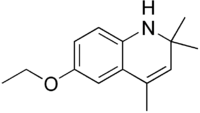Ethoxyquin
 | |
| Names | |
|---|---|
| IUPAC name
6-Ethoxy-2,2,4-trimethyl-1,2-dihydroquinoline | |
| Identifiers | |
| 91-53-2 | |
| ChEBI | CHEBI:77323 |
| ChEMBL | ChEMBL172064 |
| ChemSpider | 3177 |
| Jmol interactive 3D | Image |
| PubChem | 3293 |
| UNII | 9T1410R4OR |
| |
| |
| Properties | |
| C14H19NO | |
| Molar mass | 217.31 g·mol−1 |
| Melting point | < 25 °C (77 °F; 298 K) |
| Boiling point | 123–125 °C (253–257 °F; 396–398 K) at 2 mmHg |
| Except where otherwise noted, data are given for materials in their standard state (at 25 °C [77 °F], 100 kPa). | |
| | |
| Infobox references | |
Ethoxyquin is a quinoline-based antioxidant used as a food preservative (E324) and a pesticide (under commercial names such as "Stop-Scald") to control scald on pears after harvest.[2] It is commonly used as a preservative in pet foods to prevent the rancidification of fats. Ethoxyquin is also commonly used in spices to prevent color loss due to oxidation of the natural carotenoid pigments.[3]
There has been some speculation that ethoxyquin in pet foods might be responsible for multiple health problems. To date, the U.S. Food and Drug Administration (FDA) has only found a verifiable connection between ethoxyquin and buildup of protoporphyrin IX in the liver, as well as elevations in liver-related enzymes in some animals, but there are no known health consequences from these effects.[4] In 1997, the Center for Veterinary Medicine has asked pet food manufacturers to voluntarily limit ethoxyquin levels to 75 ppm until further evidence is reported.[4] However, most pet foods that contain ethoxyquin have never exceeded this amount.[4]
Ethoxyquin has been shown to be slightly toxic to fish.[5]
Ethoxyquin is not permitted for use in Australian foods nor is it approved for use within in the European Union.[6] It is an approved food additive in the United States.
Ethoxyquin is allowed in the fishing industry in Norway as a fat stabilizer and is therefore commonly used in food pellets fed to farmed salmon.[7]
Ethoxyquin is commonly used in pellets fed to chickens on chicken farms.[8]
The Environmental Protection Agency has concluded that any cancer risk associated with the use of ethoxyquin "does not exceed the Agency's level of concern".[3]
References
- ↑ Merck Index, 11th Edition, 3710
- ↑ EFSA Ethoxiquin
- 1 2 "R.E.D. FACTS Ethoxyquin" (PDF). United States Environmental Protection Agency. November 2004. EPA-738-F-04-006.
- 1 2 3 Pet Food Labels, U.S. Food and Drug Administration
- ↑ Ethoxyquin at the PAN pesticide database
- ↑ Noshly. "Ethoxyquin - 324 - Noshly - Food Additive & Ingredients Reference". Noshly. Retrieved 2014-08-14.
- ↑ Lundebye AK, Hove H, Måge A, Bohne VJ, Hamre K. "Levels of synthetic antioxidants (ethoxyquin, butylated hydroxytoluene and butylated hydroxyanisole) in fish feed and commercially farmed fish.". PubMed.gov. National Institute of Nutrition and Seafood Research, Bergen, Norway. Retrieved 14 August 2014.
- ↑ Rubel DM, Freeman S. (May 1998). "Allergic contact dermatitis to ethoxyquin in a farmer handling chicken feeds". Australasian Journal of Dermatology 39 (2): 89–91. PMID 9611377.